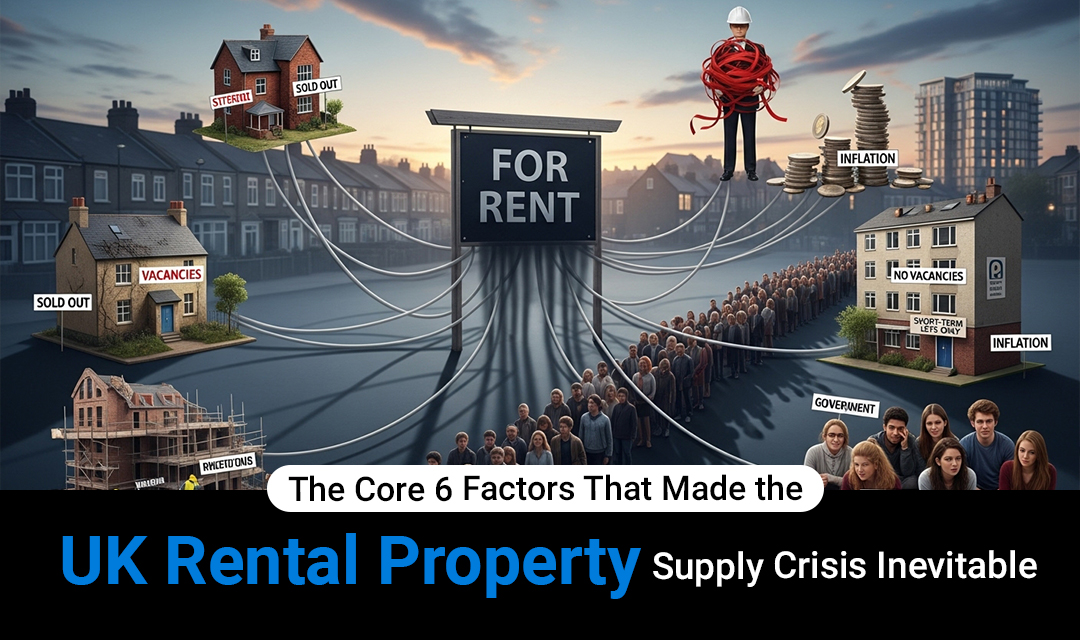How did years of policy delays and market shifts turn into today’s UK rental property supply crisis? The UK rental property supply crisis has become one of the most pressing housing issues of recent years. Across the country, tenants are facing difficulties in finding affordable homes while rents continue to rise. Landlords are leaving the market, and housing availability continues to shrink.
This situation did not happen overnight. The cause of the rental property crisis is decades of poor housing policy and increased economic strains. The imbalance between demand and supply has resulted in intense competition, which causes rental property supply crises. To get insight into why the issue has reached its inevitable stage, this article discusses six major reasons for the rental property supply crisis in the UK.
Core Ideas of The Article:
Here's what you need to know
- Chronic underbuilding and delays in planning have left the UK far behind in housing demand for decades.
- The rapid population growth has intensified the pressure on the limited rental stock in the cities and towns.
- The rising cost of construction and inflation have slowed new housing developments across the country and caused rental property crises.
- Tax changes and higher regulations have forced many landlords to leave the rental market.
- Interest rate increases have made homes unaffordable for buyers and increased demand for rental housing.
The Core 6 Factors That Made the UK Rental Property Supply Crisis Inevitable
The UK rental market is facing an unprecedented challenge that affects both tenants and landlords. Let’s explore the key factors that made the UK rental property supply crisis unavoidable.
1: Chronic Underbuilding and Planning Delays
The major factors that have led to the rental crisis in the UK include the failure of the country to build enough homes to meet the rising population. With time, the supply of new houses has always been below demand.
This shortage has become a key topic of academic analysis, particularly among UK students studying housing policy and economics. Many of them look for expert guidance from a trustworthy dissertation writing service in London to explore the long-term effects of a lack of housing supply.
The UK Parliament reported that the country requires approximately 340,000 new houses annually. This gap has resulted in a severe housing shortage, leading to rising rents.
Historical Underbuilding
Governments have made promises to encourage home construction, but they haven't done so yet. Destruction of council houses and their conversion to property developers had the effect of changing the liability rule and placing a strain on the rent costs.
Outdated Planning System
The planning process in the UK is complicated, and change is difficult. Developers often face years of delays owing to the opposition of the community and lengthy consultations.
The Consequence
These delays create a bottleneck that prevents supply from meeting demand. As a result, the competition intensifies and affordability worsens. Without modernising the planning systems and prioritising long-term building goals, the UK’s rental crisis will only deepen.
2: Rising Construction Costs and Labour Shortages
The cost of the building and a lack of skilled labour are other causes of the UK rental property crisis. The increases in the cost of construction made it difficult to provide affordable housing, particularly rental property
Material Price Inflation
Recently, construction material prices increased. The cost of Timber and energy increased due to global supply disruptions and inflation. RICS reported that the cost of construction materials rose.
The situation got worse with production, and decreased imports due to the pandemic. These irregular costs challenged budgeting for smaller developers as well as put their projects at risk.
Labour Shortages After Brexit
The free movement ended with Brexit, drastically reducing the construction workforce. The UK lost thousands of EU employees who make up a large portion of the industry. Replacement training on locals is time-consuming and expensive. Project-based learning helps to address the rising construction costs and labour shortages by developing a highly skilled and efficient workforce
The CITB indicated that the industry would require more than 250,000 more staff by 2028 to satisfy demands. The labour shortage has increased wages, further escalating construction costs and project completion times.
Impact on Rental Supply
The cheap houses are fewer when the building cost is high and there is a shortage of labour. Developers focus on the luxury projects to maintain their profit margins. This situation leads to a reduction in rental options and an increase in rental prices, exacerbating the rental crisis in the UK.
3: The Buy-to-Let Exodus
The mass exodus of the small landlords in the buy-to-let business is one of the biggest shifts in the UK rental crisis. This situation has turned their profitable investments into liabilities.
The changes to tax regulations and increases in operational costs have forced most landlords to sell their properties. Many are reducing rental supply and increasing competition among tenants.
A Shrinking Rental Market
The effect of a shrinking rental market is powerful. This has resulted in serious competition among tenants. They have limited options and less availability of the property.
Auction wars are becoming the norm, where renters will pay months of rent in advance. However, they can have a place to call home.
Widening the Housing Gap
Large investors and build-to-rent developers who target the premium properties located in major cities. As a result, rent affordability has decreased because their families travel longer distances to their places of employment and education. The exodus of buy-to-let has eventually increased the housing gap in the UK.
4: Population Growth and Urban Migration
The increasing population in the United Kingdom is slowly moving toward urban areas. It results in enormous pressure on the already struggling housing system. Over the last two decades, the population has increased by close to a million individuals.
This growth is mostly due to migration and natural development. Education and employment opportunities are additional reasons for students and professionals to move to large cities. Students who relocate for higher education seek guidance from UK-based dissertation writing services to manage their academic workload while adapting to new environments. However, the new houses have failed to keep pace with this kind of growth.
Growing Cities and Rising Pressure
London and Edinburgh are still ready to welcome thousands of new residents each year. Individuals migrate to get better jobs and a better standard of living. Nevertheless, the construction of houses in such cities has fallen behind the demand.
The Office for National Statistics found that over 13% of the London population increased over the course of a decade, while new housing increased by less than 8%. This imbalance leads to an increase in rent and triggers UK rental property supply crises.
5: Inadequate Government Housing Policies
The problem of the housing crisis in the UK has its roots in the ineffective and inconsistent government planning. Leaders evolved over the decades in terms of increasing home ownership and attempting to depend on privately built developers without a clear long-term vision. This temporary measure has created renters who are in the rental property supply crisis.
Focus on Homeownership Over Renting
In recent years, most housing schemes have aimed to assist individuals in purchasing property rather than supporting renters. The schemes of Help to Buy and Right to Buy were supposed to make ownership easier, but pushed the prices to the high end.
According to the National Audit Office, Help to Buy boosted demand without an equivalent increase in supply, which has pushed up the cost of purchasing a new house by a quarter. Limited affordable options are provided to tenants as the supply of social housing continues to decline.
Lack of Consistent Strategy
All governments have introduced new housing schemes, but few are effective in the long term. The amount of funding available to support local councils and housing associations has been unpredictable. This makes the long-term building projects challenging. There has been poor planning and weak rent control, enabling market forces to run out of control.
Consequences for Renters
As social accommodations are becoming smaller. All individuals rely on private rentals, in which home prices are increasing faster than wages. Housing benefit is not keeping pace with the rising costs, leaving low-income families in difficult circumstances.
The government is unable to determine a consistent housing plan that would combine a balance between ownership and social housing. The affordability issues will continue to grow among millions of tenants.
6: The Impact of Inflation and Interest Rates
The increasing inflation and increased interest rates have turned into a strong force that causes the crisis in the supply of rentals in the UK. All these economic demands have redefined the housing market. Maintaining properties has become harder, and finding affordable rental houses for non-owners has become harder.
Rising Interest Rates
The BBC indicated that the Bank of England has increased interest rates by 4% to control inflation. This policy serves to reduce inflation and increase the cost of credit. Landlords with variable rates now face monthly repayments that have nearly doubled.
Many small landlords are unable to manage these higher costs and have chosen to sell their rental properties. As a result, the rental stock rate has fallen while demand keeps growing.
Inflation and the Cost of Living
At the same time, inflation has raised the cost of basic goods such as food and energy, as well as the cost of maintaining buildings. These rising expenses leave the landlords with lower margins and renters with less obtainable income. When landlords raise rents to cover all costs at that time, tenants struggle even more.
Final Words
The rental property crisis in the UK did not emerge overnight. It is a culmination of decades-long underinvestment, construction pricing, landlord policy changes and economic strains. All has contributed to a weak system, which was already in a weak condition. It has decreased supply as demand continues to increase.
This crisis will just escalate unless significant reforms are made to planning and long-term housing policy. To create a rental market that benefits everyone, the way ahead needs cooperation between the government and the local authorities to put the situation back on track.
Frequently Asked Questions About the UK Rental Property Supply Crisis
How Are Tenants Impacted by the UK Rental Shortage?
The UK rental shortage is causing severe difficulties for the tenants. Demand has already exceeded supply, and rents are rising to unprecedented levels. Many people are spending a portion of their income on housing costs.
Families find it difficult to afford houses, and many young professionals are struggling to find available flats. This situation has led to reduced living space, limited choices, and increased competition in housing auctions.
Are Landlords Leaving the Market in the UK?
Many landlords are indeed withdrawing from the UK rental market. The exodus of landlords is increasing the housing shortage. An increase in financing rates, tightening of tax laws and new regulations have turned buy-to-let into a less profitable business.
A large number of small landlords are selling to owner-occupiers, further reducing rental inventory. This mass exodus has led to higher rents and increased competition. It put the tenants in a struggle in an unbalanced and expensive rental environment.










